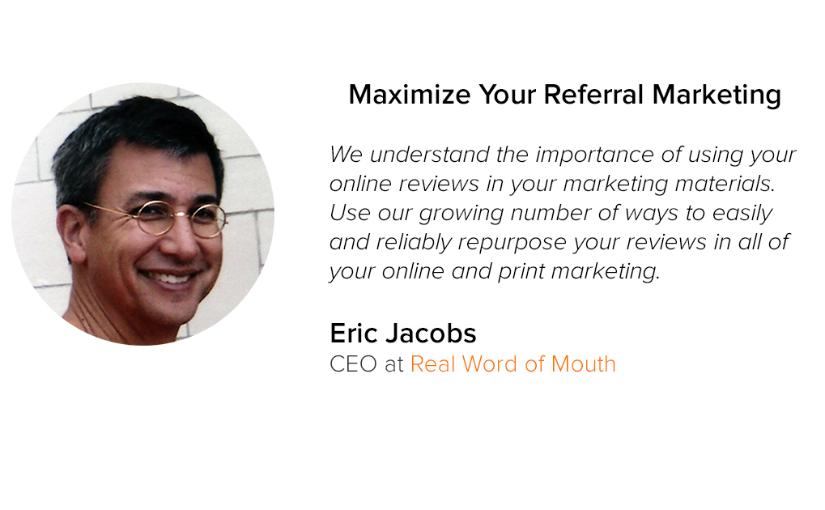Reviews and testimonials are powerful marketing tools. They help communicate what kind of experience others have had with your service and can serve as a form of “word of mouth”. It’s natural and makes sense to quote reviews and testimonials on your own website, in your print marketing materials, in social media, and in your online ads.
There’s a right way and wrong way to quote reviews and testimonials. We’ll show you how to get the most out of your reviews.
Third-party review sites are key
How do your visitors and readers know that those reviews or testimonials on your website or in your marketing literature are real? That they are written by real clients? Is a review or testimonial by “John D.” in San Francisco even written by a real person?
This is where third-party review sites like Real Word of Mouth, Yelp, Google+, and Facebook come in. Third-party review sites have processes and tools that they use to vet reviews, reviewers, and even business listings. These sites add credibility and valuable marketing authority to your reviews.
To correctly take advantage of third-party review sites, it is important to attribute the review, quote, or testimonial to the person who wrote the review, and to give credit to the third-party website that is providing the review. On your website, you would provide a link to the third-party “source” of the review or testimonial, so that your visitors can vet the review for themselves by visiting the website. In print marketing, you would give credit to the third-party within your literature.
Do’s and don’ts when quoting reviews
There are right ways and a wrong ways to quote reviews. If you don’t quote a review correctly, not only will you not realize the full value of the review, but the third-party that provides the review might ask you to stop using the review.
Here are 10 steps to using third-party reviews in your marketing materials – the “do’s and don’ts” that will help you get the most out of your online reviews:
1. Check if the third-party Terms of Service allows you to quote reviews. Many services do not allow quoting of reviews, and if they do, you need to follow their rules. This should be the first thing you do before quoting reviews on your website, in an online ad, or in your print marketing literature. Real Word of Mouth allows you to quote your reviews, provided that you follow the steps below.
2. Only quote reviews that are visible on a third-party website. Don’t use reviews that are hidden, filtered, or “not recommended”. Otherwise, when someone visits the third-party website and cannot find the review that you quoted, they will wonder if your quotes, reviews, and testimonials are real.
3. Ask your client if it is okay to use their words on your website or in your marketing literature. There is nothing worse than an irate client who discovers their review quoted in a brochure when they weren’t asked first.
4. Ask your client how they want to be attributed. Is it okay to use their full name, or their first name and their last initial? Do they prefer to be “Anonymous”? Can you use their picture?
5. Ask if you can describe their purchase or profession, for example “Surround sound customer”, “HR professional”, “Senior Loan Officer”, “Software Engineer at Widget Corp”, or other relevant description.
6. Don’t edit the review or substitute words. It’s important to be faithful to the original review to use the review credibly, and without upsetting the person who wrote the review.
7. Don’t take a quote out of context. For example, don’t selectively quote a positive statement that’s part of a negative review.
8. Provide attribution to the third-party source of the review or quote. For example, provide a link to the webpage where the reviews are displayed. Title the link with the name of the website or service (i.e. “Real Word of Mouth” or “Reviews from Real Word of Mouth”)
9. Follow any third-party branding guides, such as how to use third-party logos and the company name.
10. Use third-party widgets, badges, or buttons to attribute the third-party source on your website, because these will often automatically handle some or all of the items 1 through 9 above.
Who owns the review?
You might think that “your reviews” are yours. They actually aren’t. Basically your client owns their reviews.
“Who owns the review?” is a common question and often an area of confusion for business owners. The person who wrote the review “owns” their own words.
Here’s how it works. When submitting a review, a client will grant the third-party service a license that gives the third-party website the right to use the review in any number of ways outlined in their Terms of Service, including whether the review can be quoted by others. This is why it’s extremely important to check if the third-party allows you, the business owner, to quote your reviews.
Real Word of Mouth
We understand the importance of using your online reviews in your marketing materials. Use our growing number of ways to easily and reliably repurpose your reviews in all of your online and print marketing.

